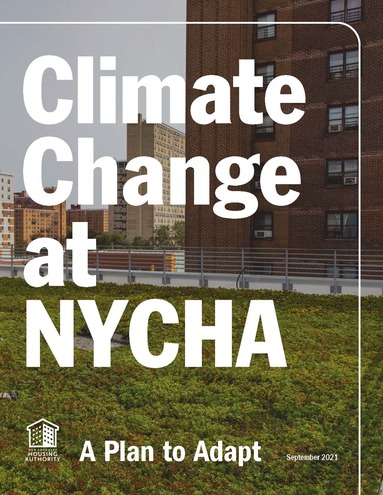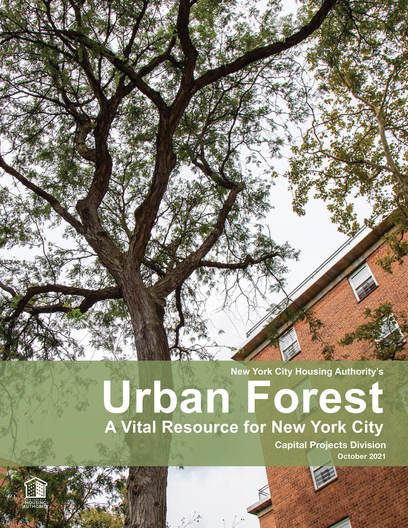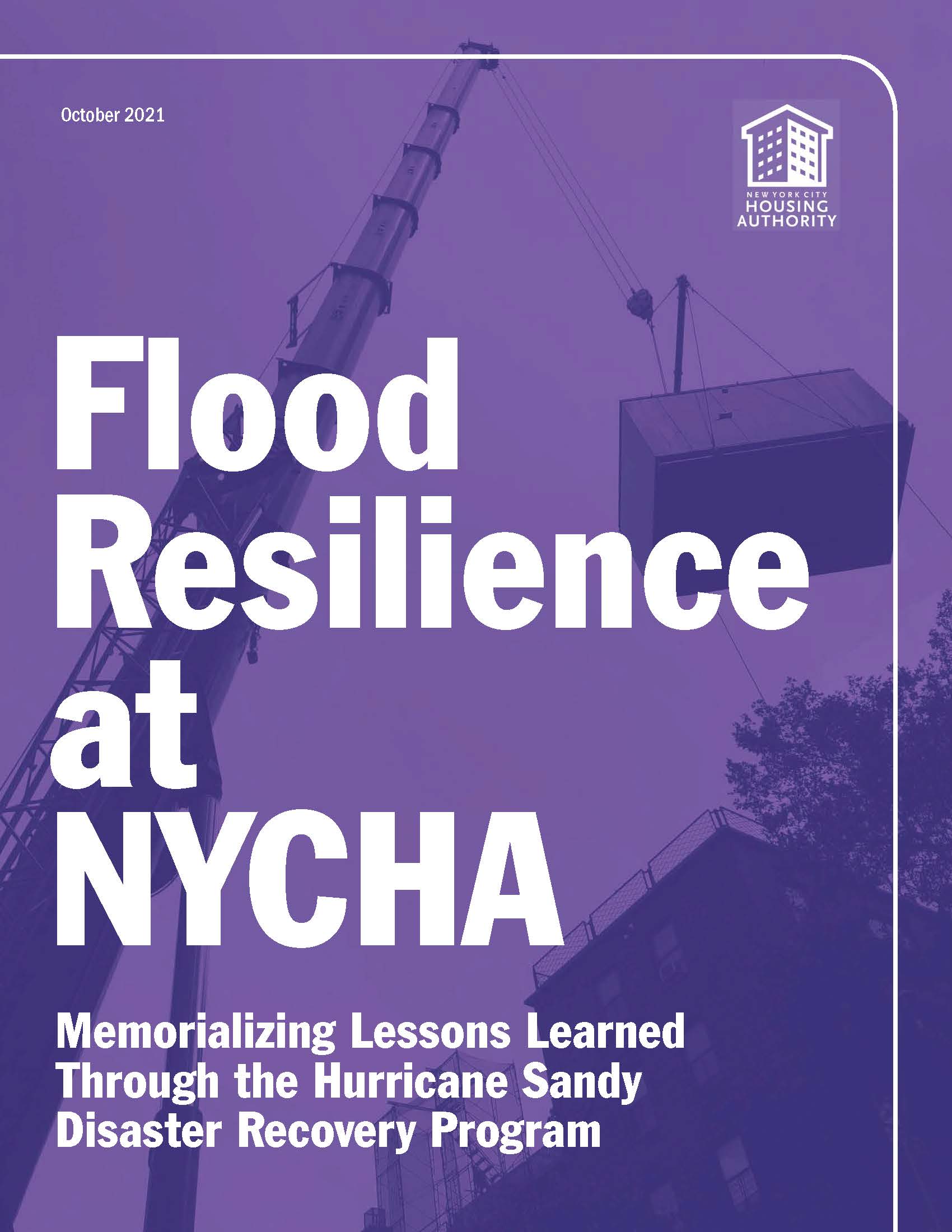
 NYC Housing Authority311
NYC Housing Authority311 Search all NYC.gov websites
Search all NYC.gov websites
Climate Adaptation at NYCHA
Climate change is a reality in New York City: summers are getting hotter, rain is becoming heavier and more frequent, and sea level rise is making us more vulnerable to coastal flooding. NYCHA is working to be ready for the threats posed by a changing climate by building climate adaptation strategies into its capital investments. The Climate Adaptation Plan lays out the Authority’s current understanding of how climate-induced hazards will affect NYCHA in the coming decades; points out where there are specific vulnerabilities to climate-induced hazards; and provides an approach to preparing NYCHA for a changing climate. The plan was informed by existing initiatives to protect over 200 buildings from storm surge as part of the Sandy recovery program, rainwater capture projects designed at almost three dozen developments in cooperation with NYC Department of Environmental Protection, and in-home cooling pilots that NYCHA has already launched. It was also guided by stakeholder input collected throughout these projects and, specifically, guidance from the Citywide Council of Presidents and NYCHA’s resident Network for Climate Action.
Climate Change at NYCHA: A Plan to Adapt outlines NYCHA’s approach to mitigating climate-induced hazards that will impact NYCHA developments.
This plan sets seven goals to put this approach into action:
-
Build resilience into NYCHA’s capital work – As NYCHA implements a comprehensive plan to finance capital work to stabilize housing quality across its portfolio, it is integrating the most current knowledge about future climate conditions.
-
Foster the health of NYCHA’s urban forest – As the owner of 1,000 acres of tree canopy, NYCHA’s trees provide enormous benefits and the agency is looking to strengthen maintenance, preservation, and replacement programs.
-
Expand access to reliable, efficient cooling in NYCHA apartments – Expanding access to indoor cooling is the most effective way to maintain safety from extreme heat. Combined with improved building insulation and enhanced tree canopy, NYCHA will reduce resident vulnerability to heat-related fatalities.
-
Prepare developments to manage heavier, more frequent rainstorms – Decreasing impervious surface and integrating stormwater management and retention into grounds projects can be implemented in conjunction with comprehensive modernization or on a component basis.
-
Protect critical infrastructure at developments exposed to coastal flooding – There are hundreds of buildings – beyond those already protected – that will be located within the 100-year floodplain by 2100. NYCHA plans to prioritize protection of critical infrastructure at these developments.
-
Prepare for additional hazards – Beyond the major hazards, NYCHA is tracking the data associated with rising groundwater, extreme winds, cold snaps, and secondary risks, such as utility outages and transportation impacts.
-
Invest in social resilience at NYCHA – Leveraging the strong existing connections and programs led by NYCHA residents and their allies, capital investments can create and enhance the physical spaces that support social resilience.
Two companion documents support NYCHA’s climate adaptation planning.
NYCHA’s Urban Forest: A Vital Resource for New York City identifies the essential role that NYCHA’s trees play in a resilient future and outlines strategies for protecting and enhancing NYCHA’s piece of the New York City urban forest.
“NYCHA’s Urban Forest: A Vital Resource for New York City” makes progress on Goal 2 by presenting analysis of the value of NYCHA’s trees and what the Authority must do to preserve the benefits trees bring to NYCHA residents. This report was produced in collaboration with several partner organizations: Green City Force, the US Forest Service’s New York City Urban Field Station, and The Nature Conservancy, with support from the Mayor’s Office of Climate Resiliency and the New York City Department of Health and Mental Hygiene. The report shows that:
-
NYCHA’s trees provide measurable mitigation of the Urban Heat Island Effect on NYCHA campuses, as well as beauty, respite, and comfort for residents. They are an essential resource for both NYCHA and the city as a whole;
-
Elevated care for NYCHA’s trees has the potential to foster career pathways to urban forestry for NYCHA residents;
-
NYCHA is committing to making improvements in tree care and preservation by working to devote staff to tree care and building partnerships to leverage external support and expertise.
Flood Resilience at NYCHA: Memorializing Lessons Learned from the Hurricane Sandy Disaster Recovery Program documents the flood protection strategies used after Sandy and the considerations that should be integrated into future flood protection projects.
In support of Goal 5: Protect Critical Infrastructure at Developments Exposed to Coastal Flooding, NYCHA has developed “Flood Resilience at NYCHA: Memorializing Lessons Learned Through the Hurricane Sandy Disaster Recovery Program”. This document looks at the benefits and challenges associated with various strategies incorporated in the retrofit projects to protect NYCHA buildings from coastal flooding, documenting design decisions and their consequences in order to benefit future flood protection efforts. The report provides details on NYCHA’s experience with:
-
Installing sustainable and resilient critical infrastructure. Some of Hurricane Sandy’s most acute impacts at NYCHA were a result of outages of its most critical systems: heat, hot water, and power. Recovering from Sandy and building resilience to future storms involved, replacing heat and hot water systems with new equipment and providing for backup power generation in case of future outages.
-
Protecting mechanical, electrical & plumbing infrastructure. Heat, hot water, and electrical equipment was protected from future flooding by raising areas or floodproofing areas inside buildings, moving equipment to building rooftops, or shifting equipment to newly constructed annexes.
-
Protecting structures. Protecting areas below grade and on the first floor required a menu of strategies, including dry floodproofing, which prevents water from entering the building entirely, and wet floodproofing, which allows water to enter and exit the building while ensuring that critical equipment and other essential uses are out of the potentially inundated zones.
-
Engaging the community. Resident engagement is critical at every step of the disaster recovery process including, advocating for funding, incorporating input into design, supporting residents during disruptive construction, and educating on flood protection elements that have been installed.
Stakeholder Engagement Process
The success and longevity of NYCHA’s climate adaptation goals are greatly dependent on resident engagement. NYCHA staff are committed to working collaboratively with its residents and other key stakeholders to ensure the values of transparency, trust, accountability, and inclusivity were included during the development of this policy document.
During the development of this document, NYCHA conducted a robust resident and stakeholder engagement process that involved technical panels, a collaborative session with the Citywide Council of Presidents, and a workshop series with residents – the Network for Climate Action. The Network was developed in collaboration with NYCHA’s Sustainability team and the Pratt Center for Community Development. Through a series of five workshops during 2021, group members learned about NYCHA’s climate risks and sustainability goals, evaluated proposed solutions, contributed ideas, and identified priorities for NYCHA. The resident members will be invited to contribute and evaluate ideas on an ongoing basis.
By documenting and drawing lessons from its current and past resiliency projects, the Climate Adaptation Plan utilized a participatory process of monitoring, learning, and action.






